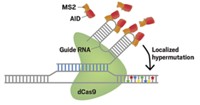Advertisement
Grab your lab coat. Let's get started
Welcome!
Welcome!
Create an account below to get 6 C&EN articles per month, receive newsletters and more - all free.
It seems this is your first time logging in online. Please enter the following information to continue.
As an ACS member you automatically get access to this site. All we need is few more details to create your reading experience.
Not you? Sign in with a different account.
Not you? Sign in with a different account.
ERROR 1
ERROR 1
ERROR 2
ERROR 2
ERROR 2
ERROR 2
ERROR 2
Password and Confirm password must match.
If you have an ACS member number, please enter it here so we can link this account to your membership. (optional)
ERROR 2
ACS values your privacy. By submitting your information, you are gaining access to C&EN and subscribing to our weekly newsletter. We use the information you provide to make your reading experience better, and we will never sell your data to third party members.
Biological Chemistry
DNA Scribes Seen Live
Single-molecule fluorescence unveils rate-determining step for transcription
by Carmen Drahl
April 25, 2011
| A version of this story appeared in
Volume 89, Issue 17
A bank heist is only as fast as the slowest thief, and according to single-molecule studies, genes have a similar limitation. With a fluorescence tracking method, Robert H. Singer at Albert Einstein College of Medicine and colleagues have learned that the rate at which genes are turned on depends on the time it takes for a protein called a transcription factor to hunt down its proper spot on DNA (Science, DOI: 10.1126/science.1202142). Molecular biologists want to learn more about the workings of transcription factor proteins, which bind to DNA to regulate gene expression. Singer’s team engineered nascent RNAs to bind to a molecule of green fluorescent protein, which let them follow transcription in single, live yeast cells with a fluorescence microscope. They learned that the time it took a transcription factor called Mbp1p to find its binding site on DNA dictated gene turn-on rate. The authors say their live-cell technique could unravel the roles of many more players in transcription.





Join the conversation
Contact the reporter
Submit a Letter to the Editor for publication
Engage with us on Twitter